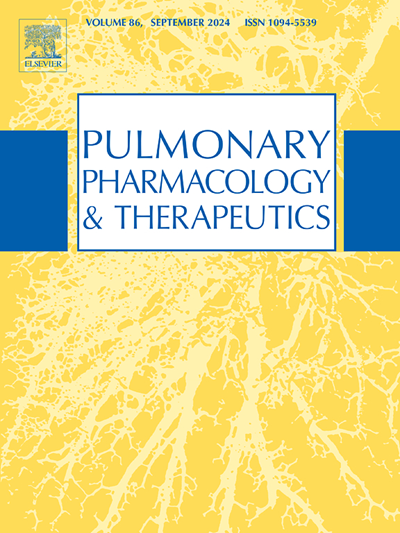糠酸莫米松、丙酸氟替卡松和糠酸氟替卡松临床药理学比较
摘要
目的探讨糠酸莫米松(MF)、丙酸氟替卡松(FP)和糠酸氟替卡松(FF)的药代动力学及其对下丘脑-垂体-肾上腺(HPA)轴的影响。方法研究1:14名健康受试者采用随机、单剂量、四向交叉设计,分别接受吸入和静脉注射MF(通过Twisthaler吸入剂量)和FP(通过Diskus吸入剂量),剂量均为400 μg。研究2:27名轻度至中度哮喘患者,停用皮质类固醇药物5天以获得基线24小时血清皮质醇,接受吸入MF Twisthaler和FP Diskus,剂量均为400 μg,每日两次(BID),采用随机,14天重复剂量,双向交叉设计。研究3:44名健康参与者被随机分配到一项双盲、安慰剂对照、五期交叉研究中,通过吸入途径给予以下治疗7天:FP Diskus(250、500、1000 μg BID), FF Diskus(100、200、400、800、1600 μg每日一次[QD])或安慰剂Diskus。在每项研究中,收集24小时的连续血液样本并测定MF、6β-羟基莫米松、莫米松、FP、FF和皮质醇的浓度。药代动力学和血清皮质醇参数以几何平均值和95%置信区间(CI)估计。结果研究1:静脉注射MF和FP:绝对生物利用度分别为11.4% (95% CI: 7.5, 17.6)和7.8% (6.3,9.6);血浆清除率分别为47 L/h(41,52)和60 L/h (52,69);半衰期为7.4 h(6.9, 8.0)和7.2 h (6.5, 8.0);分布体积分别为499 L(439、567)和623 L(557、698)。吸入单剂量MF或FP对血清皮质醇没有显著影响(较基线降低10%),而静脉注射MF或FP分别使血清皮质醇较基线降低约- 50%。研究2:MF和FP:第1天曲线下面积分别为421 pg h/mL(270、659)和248 pg h/mL(154、400),第14天为1092 pg h/mL(939、1269)和591 pg h/mL(501、696);绝对生物利用度分别为12.8%(11.2,14.2)和8.9%(7.7,10.2)。第14天,MF和FP的24小时血清皮质醇较基线变化分别为- 35%(- 44%,- 26%)和- 18% (- 28%,- 5%);MF组皮质醇浓度的降低明显大于FP组(几何校正平均血清皮质醇浓度比值:1.28[1.04,1.56])。静脉给药(研究1)和多次吸入给药(研究2)后血浆6β-羟基莫米松浓度低;在任何样本中均未检测到莫米松。研究3:吸入FP和FF具有相似的系统生物利用度估计(分别为12.0%[11.0,13.2]和15.0%[12.0,17.3]),但对HPA轴的影响不同,这与FF比FP高1.7倍的糖皮质激素受体结合亲和力相一致。然而,FP 250 μg BID和FF 100、200和400 μg QD组血清皮质醇的降低与安慰剂组无显著差异。在较高剂量下,FP 500和1000 μg BID, FF 800和1600 μg QD,血清皮质醇浓度相对于安慰剂的变化分别为- 30%,- 70%,- 41%和- 90%。重复吸入FP 1000 μg/天(在治疗剂量范围内)导致与治疗范围内MF相当的皮质醇抑制(减少30%);而对于FF,这种情况发生在治疗剂量范围(644 μg/天)的3倍以上。结论单次吸入和静脉注射剂量的MF和FP (400 μg)具有相似的生物利用度和降低血清皮质醇的作用。在治疗范围内(800 μg/天)重复给药吸入MF和FP,导致MF更大的全身暴露,血清皮质醇下降35%,是FP的2倍。较高的糖皮质激素受体结合亲和力和生物利用度,较低的清除率和活性代谢物的存在可能导致MF更大的全身暴露和对皮质醇的影响。重复给药吸入FP和FF导致相似的全身生物利用度,但在治疗范围内,与MF相比,皮质醇抑制所需的剂量不同。与FP和FF不同,MF具有活性代谢物,可能有助于其全身作用,而含有MF的产品之间也存在器械/配方性能差异。Aims
To investigate the pharmacokinetics and effects on the hypothalamic-pituitary-adrenal (HPA) axis of mometasone furoate (MF), fluticasone propionate (FP) and fluticasone furoate (FF).
Methods
Study 1: Fourteen healthy participants received inhaled and intravenous MF (inhaled dose via Twisthaler) and FP (inhaled dose via Diskus), both given at 400 μg, using a randomised, single-dose, four-way crossover design. Study 2: Twenty-seven participants with mild to moderate asthma, who discontinued their corticosteroid medication for 5 days to obtain a baseline 24 h serum cortisol, received inhaled MF Twisthaler and FP Diskus, both given at 400 μg twice daily (BID), using a randomised, 14-day repeat dose, two-way crossover design. Study 3: Forty-four healthy participants were randomised to a double-blind, placebo-controlled, five-period crossover study where the following treatments were administered via the inhaled route for 7 days: FP Diskus (250, 500, 1000 μg BID), FF Diskus (100, 200, 400, 800, 1600 μg once daily [QD]) or placebo Diskus. In each study, 24-h serial blood samples were collected and assayed to assess concentrations of MF, 6β-hydroxy mometasone, mometasone, FP, FF and cortisol. Pharmacokinetic and serum cortisol parameters were estimated as geometric means and 95% confidence intervals (CI).
Results
Study 1: For intravenous MF and FP, respectively: absolute bioavailability was 11.4% (95% CI: 7.5, 17.6) and 7.8% (6.3, 9.6); plasma clearance was 47 L/h (41, 52) and 60 L/h (52, 69); half-life was 7.4 h (6.9, 8.0) and 7.2 h (6.5, 8.0); and volume of distribution was 499 L (439, 567) and 623 L (557, 698). Inhalation of single dose MF or FP did not significantly affect serum cortisol (<10% reduction from baseline), whereas intravenous administration of MF or FP each changed serum cortisol by approximately −50% from baseline. Study 2: For MF and FP, respectively: area under the curve up to the last measurable concentration on Day 1 was 421 pg h/mL (270, 659) and 248 pg h/mL (154, 400), and on Day 14 was 1092 pg h/mL (939, 1269) and 591 pg h/mL (501, 696); absolute bioavailability was 12.8% (11.2, 14.2) and 8.9% (7.7, 10.2). On Day 14, 24-h serum cortisol change from baseline was −35% (−44%, −26%) and −18% (−28%, −5%) for MF and FP, respectively; the reduction was significantly greater for MF than FP (ratio for geometric adjusted mean serum cortisol concentration: 1.28 [1.04, 1.56]). Low plasma concentrations of 6β-hydroxy mometasone were detected after intravenous dosing (Study 1) and after multiple inhaled dosing (Study 2); mometasone was not detected in any samples. Study 3: Inhaled FP and FF had similar systemic bioavailability estimates (12.0% [11.0, 13.2] and 15.0% [12.0, 17.3], respectively), but a differential effect on the HPA axis which was in agreement with the known 1.7-fold higher glucocorticoid receptor-binding affinity of FF versus FP. However, for FP 250 μg BID and FF 100, 200 and 400 μg QD, reduction in serum cortisol was not significantly different from placebo. For higher doses, FP 500 and 1000 μg BID, and FF 800 and 1600 μg QD, changes in serum cortisol concentration relative to placebo were −30%, −70%, −41% and −90%, respectively. Repeat inhaled dosing of FP 1000 μg/day (within the therapeutic dose range) resulted in comparable cortisol suppression to MF in the therapeutic range (30% reduction); whereas for FF this occurred at more than 3-fold above the therapeutic dose range (644 μg/day).
Conclusions
Single inhaled and intravenous doses of MF and FP (400 μg) resulted in similar bioavailability and reductions in serum cortisol. Repeat dosing of inhaled MF and FP in the therapeutic range (800 μg/day) resulted in greater systemic exposure for MF, and a 35% reduction in serum cortisol that was 2-fold greater than for FP. The higher glucocorticoid receptor-binding affinity and bioavailability, lower clearance and the presence of active metabolites may contribute to the greater systemic exposure and effect on cortisol for MF. Repeat dosing of inhaled FP and FF resulted in similar systemic bioavailability but differed in terms of the dose required for comparable cortisol suppression to MF in the therapeutic range. Unlike FP and FF, MF has active metabolites that may contribute to its systemic effects, while device/formulation performance differences also exist between MF-containing products.

 求助内容:
求助内容: 应助结果提醒方式:
应助结果提醒方式:


